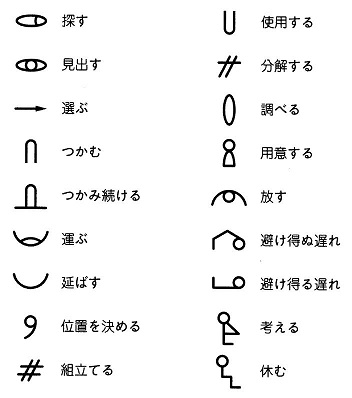
図1 サーブリッグ
Gilbreth , F. B., & Gilbreth, L. M. (1917). Applied motion study: A collection of papers on the efficient method to industrial preparedness. New York, NY: Sturgis & Walton, London: George Routledge & Sons. (この他にも、New York, NY: Macmillan 版(c1917, 1919)、London,UK: George Routledge & Sons版(1918)が存在する。) 【解説】
ギルブレス夫妻(Frank and Lilian Gilbreth)に代表される動作研究では、動作の改善が目的とされ、その際に用いられる図1のような「サーブリッグ」は、現在でも用いられ、有名である。ここで、サーブリッグ(therblig)とは、手作業の単位動作を表す記号で、ギルブレス(Gilbreth)の綴りを逆から読んだものである。サーブリッグの原型は、1915年に米国機械技師協会(The American Society of Mechanical Engineers; ASME)のニューヨークの地方大会で発表された論文 “Motion study for crippled soldier” で登場する。この論文は1915年に、米国機械技師協会誌(Journal of the American Society of Mechanical Engineers)に掲載されたが、1917年に本書の第7章(pp.131-157)として収録される。ただし、まだ「サーブリッグ」という用語は用いられておらず、16種の要素(the elements of a cycle of decisions and motions)が列挙されているだけで、そこには記号も掲載されていない(p.138)。後になって「つかみ続ける(hold)」と「考える(plan)」が追加されて、サーブリッグは図1のように18種になった。動作節約(motion economy)は、主にこうしたギルブレス夫妻の研究に由来する(March & Simon, 1993, p.39 邦訳p.26)。

図1 サーブリッグ